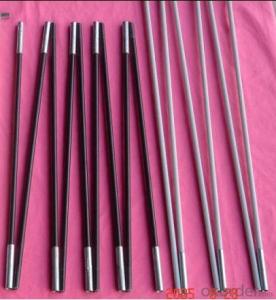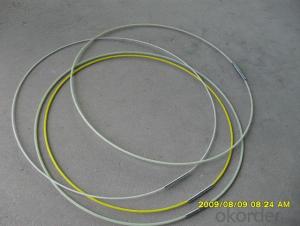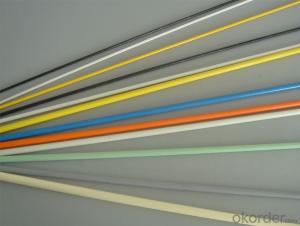Pultruded Frp Rod
- Loading Port:
- China Main Port
- Payment Terms:
- TT OR LC
- Min Order Qty:
- -
- Supply Capability:
- -
OKorder Service Pledge
Quality Product, Order Online Tracking, Timely Delivery
OKorder Financial Service
Credit Rating, Credit Services, Credit Purchasing
You Might Also Like
Specifications of Pultruded Frp Rod:
1. corrosion resistant,lightweight, extremely strong and durable
2. chemical proof, non-conductive
Size and Weight of Pultruded Frp Rod:
item | Size(mm) | Weight(kg/m) |
Solid fiberglass Rod | 6.9 | 0.077 |
7.3 | 0.083 | |
7.9 | 0.1 | |
8.5 | 0.116 | |
9.5 | 0.145 | |
10 | 0.16 | |
11 | 0.194 | |
12 | 0.231 | |
12.7 | 0.259 | |
16 | 0.395 | |
18 | 0.51 | |
25 | 0.95 |
- Q:Are FRP pultrusion profiles resistant to moisture absorption?
- Yes, FRP (Fiber Reinforced Polymer) pultrusion profiles are highly resistant to moisture absorption. This is due to the nature of the material used in their construction, which typically includes a combination of fiberglass and resin. Fiberglass is inherently non-porous and does not absorb moisture, while the resin used in FRP pultrusion profiles is specifically formulated to be moisture-resistant. The pultrusion process used to manufacture FRP profiles also contributes to their moisture resistance. During pultrusion, the fiberglass and resin are pulled through a heated die, which not only ensures thorough impregnation of the fibers with resin but also creates a solid, dense structure. This results in a product that is highly resistant to water penetration and moisture absorption. Furthermore, FRP pultrusion profiles can be further enhanced with the addition of protective coatings or surface treatments, such as gel coats or UV-resistant finishes, which provide an additional barrier against moisture ingress. The moisture resistance of FRP pultrusion profiles makes them an excellent choice for applications where exposure to water or high humidity is expected, such as in marine environments, wastewater treatment plants, or outdoor structures. Their resistance to moisture absorption helps to prevent issues like rot, rust, or degradation commonly associated with other materials like wood or metal. Overall, FRP pultrusion profiles offer a reliable and durable solution that can withstand moisture exposure without compromising their structural integrity or performance.
- Q:Are FRP pultrusion profiles impact resistant?
- Yes, FRP (Fiber Reinforced Polymer) pultrusion profiles are generally known for their high impact resistance. The combination of reinforcing fibers, such as glass or carbon, with a polymer matrix results in a material that is inherently strong and durable. The pultrusion process further enhances the impact resistance of these profiles by aligning the fibers in the direction of the load, providing optimal strength against impacts. FRP pultrusion profiles also have a high strength-to-weight ratio, which allows them to withstand heavy impacts without significant damage or deformation. This makes them suitable for applications where impact resistance is crucial, such as in construction, transportation, and infrastructure projects. Moreover, FRP pultrusion profiles offer excellent resistance against corrosion, chemicals, and UV radiation, which further contribute to their durability and long-term performance. These profiles can maintain their impact resistance properties even in harsh environments, making them a preferred choice for various industries. However, it is important to note that the specific impact resistance of FRP pultrusion profiles may vary depending on the specific design, composition, and manufacturing process. Therefore, it is recommended to consult with the manufacturer or supplier to ensure the profiles meet the desired impact resistance requirements for a particular application.
- Q:Can FRP profiles replace carbon steel profiles?
- I am a man of glass fiber reinforced material. Honestly, "I can't do it."". Can be used in buildings, such as insulation, corrosion protection, aging resistance, flame retardant, etc.,
- Q:Are FRP pultrusion profiles resistant to termites?
- Yes, FRP pultrusion profiles are resistant to termites. Due to their composition of fiberglass and resin, they are not a food source for termites and are therefore not susceptible to termite damage.
- Q:Can FRP pultrusion profiles be used in automotive applications?
- Yes, FRP (Fiber Reinforced Polymer) pultrusion profiles can be used in automotive applications. FRP pultrusion profiles offer several advantages that make them suitable for automotive use. Firstly, FRP pultrusion profiles are lightweight yet strong, which is crucial in the automotive industry where reducing weight is a priority for improving fuel efficiency and performance. The high strength-to-weight ratio of FRP profiles allows for the design of lighter and more fuel-efficient vehicles. Secondly, FRP pultrusion profiles possess excellent corrosion resistance, which is important for automotive applications where exposure to various chemicals, moisture, and harsh environments is common. This resistance to corrosion ensures the long-term durability and reliability of the profiles, reducing maintenance costs and increasing the lifespan of automotive components. Additionally, FRP pultrusion profiles offer design flexibility, enabling the creation of complex shapes and geometries that can be customized to meet specific automotive requirements. This flexibility allows for the integration of FRP profiles in various automotive components, such as body panels, structural supports, interior trims, and suspension parts. Furthermore, FRP pultrusion profiles exhibit high fatigue resistance, which is crucial for automotive applications that involve repetitive loading and vibrations. The fatigue resistance of FRP profiles ensures their long-term performance and helps prevent failures and breakdowns. Lastly, FRP pultrusion profiles are electrically non-conductive, which is beneficial for automotive applications where electrical isolation is required. This property eliminates the need for additional insulation and reduces the risk of electrical failures and short circuits. Overall, the combination of lightweight, high strength, corrosion resistance, design flexibility, fatigue resistance, and electrical non-conductivity makes FRP pultrusion profiles suitable for various automotive applications, contributing to improved performance, fuel efficiency, durability, and safety in the automotive industry.
- Q:How do FRP pultrusion profiles perform in heavy-load applications?
- The exceptional performance of FRP pultrusion profiles in heavy-load applications is well-known. These profiles can withstand substantial loads without compromising structural integrity, thanks to their high strength-to-weight ratio. The pultrusion process ensures that the fibers are uniformly distributed and aligned along the length of the profile, resulting in superior strength and stiffness. In heavy-load applications, FRP pultrusion profiles demonstrate excellent load-bearing capabilities. They possess a high modulus of elasticity, enabling them to resist deformation under heavy loads and ensuring long-term durability. Moreover, these profiles have a high ultimate tensile strength, allowing them to withstand extreme forces without breaking or deforming. Additionally, FRP pultrusion profiles exhibit corrosion resistance, making them ideal for use in harsh environments. Unlike traditional materials such as steel, FRP does not rust or corrode, ensuring a longer lifespan and reduced maintenance costs. Another advantage of FRP pultrusion profiles in heavy-load applications is their electrical insulation properties. They do not conduct electricity, making them suitable for environments where electrical conductivity is a concern. Furthermore, compared to traditional materials like steel or concrete, FRP pultrusion profiles are lightweight. This characteristic simplifies transportation and installation, while also reducing overall project costs. In conclusion, FRP pultrusion profiles excel in heavy-load applications. Their high strength-to-weight ratio, excellent load-bearing capabilities, corrosion resistance, electrical insulation properties, and lightweight nature make them the preferred choice for various industries, including construction, infrastructure, marine, and transportation.
- Q:Are FRP pultrusion profiles resistant to rotting or decaying?
- FRP pultrusion profiles possess a high resistance to rot and decay due to their composition, consisting of a combination of fiber reinforcement, like fiberglass, and a polymer resin matrix. Unlike wood and other conventional materials that rot and decay when exposed to moisture and environmental elements, FRP profiles do not absorb water as they are non-porous. Moreover, the polymer resin employed in FRP exhibits exceptional resistance to chemical corrosion, rendering it impervious to rot-causing agents such as fungi or bacteria. Consequently, FRP pultrusion profiles boast a significantly longer lifespan and necessitate minimal maintenance in comparison to traditional materials, making them an exceptional choice for applications that demand resistance to rot or decay.
- Q:Are FRP pultrusion profiles resistant to fading or discoloration?
- Yes, FRP pultrusion profiles are highly resistant to fading or discoloration. The profiles are made with high-quality resins and UV stabilizers that provide excellent protection against sunlight, chemicals, and environmental factors, ensuring long-term color stability and preventing any significant fading or discoloration.
- Q:Can FRP pultrusion profiles be used in the construction of solar panel frames?
- Yes, FRP (Fiber Reinforced Polymer) pultrusion profiles can be used in the construction of solar panel frames. FRP pultrusion profiles are lightweight, strong, and resistant to corrosion, making them an ideal material choice for solar panel frames. The durability and high strength-to-weight ratio of FRP pultrusion profiles ensure that the frames can withstand various weather conditions and long-term exposure to sunlight. Additionally, FRP pultrusion profiles can be easily customized to meet specific design requirements, allowing for flexibility in the construction of solar panel frames. Overall, the use of FRP pultrusion profiles in solar panel frame construction offers numerous advantages, making it a suitable choice for the solar energy industry.
- Q:What are the circumstances in which the pultrusion should be performed?
- The roving yarn assembly in yarn frame, yarn unwinding through a series of guide roller and cluster grid plate, roller set, enter the resin impregnated resin impregnated yarn groove. Then through the pre forming die, the die is required according to the shape of products and configuration in the guiding device. The mold after discharge excess resin and bubbles into the cold. Cold mold cooling by cooling water, so that the resin viscosity, reduce the loss, and finally into the mold, the fiber reinforced material and resin molding in mold curing, and then the traction device is pulled, cut into required length of products by cutting device.
1. Manufacturer Overview |
|
|---|---|
| Location | |
| Year Established | |
| Annual Output Value | |
| Main Markets | |
| Company Certifications | |
2. Manufacturer Certificates |
|
|---|---|
| a) Certification Name | |
| Range | |
| Reference | |
| Validity Period | |
3. Manufacturer Capability |
|
|---|---|
| a)Trade Capacity | |
| Nearest Port | |
| Export Percentage | |
| No.of Employees in Trade Department | |
| Language Spoken: | |
| b)Factory Information | |
| Factory Size: | |
| No. of Production Lines | |
| Contract Manufacturing | |
| Product Price Range | |
Send your message to us
Pultruded Frp Rod
- Loading Port:
- China Main Port
- Payment Terms:
- TT OR LC
- Min Order Qty:
- -
- Supply Capability:
- -
OKorder Service Pledge
Quality Product, Order Online Tracking, Timely Delivery
OKorder Financial Service
Credit Rating, Credit Services, Credit Purchasing
Similar products
New products
Hot products
Related keywords





























